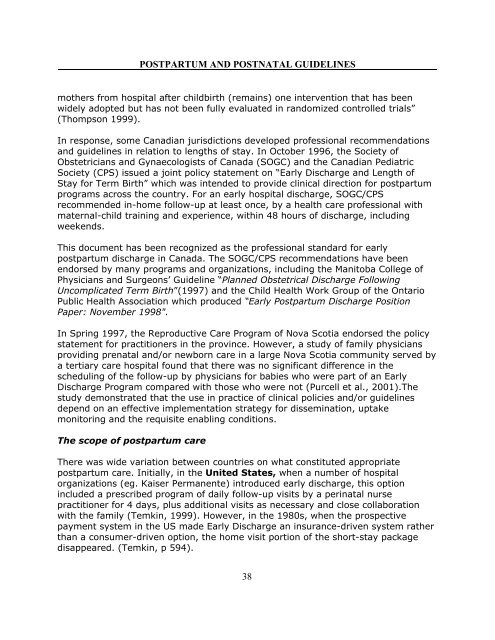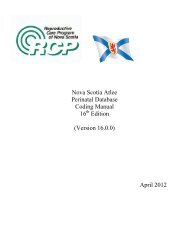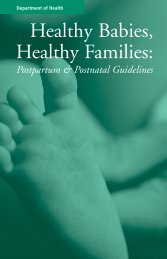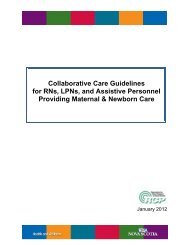Postpartum & Postnatal Guidelines - Reproductive Care Program of ...
Postpartum & Postnatal Guidelines - Reproductive Care Program of ...
Postpartum & Postnatal Guidelines - Reproductive Care Program of ...
You also want an ePaper? Increase the reach of your titles
YUMPU automatically turns print PDFs into web optimized ePapers that Google loves.
POSTPARTUM AND POSTNATAL GUIDELINES<br />
mothers from hospital after childbirth (remains) one intervention that has been<br />
widely adopted but has not been fully evaluated in randomized controlled trials”<br />
(Thompson 1999).<br />
In response, some Canadian jurisdictions developed pr<strong>of</strong>essional recommendations<br />
and guidelines in relation to lengths <strong>of</strong> stay. In October 1996, the Society <strong>of</strong><br />
Obstetricians and Gynaecologists <strong>of</strong> Canada (SOGC) and the Canadian Pediatric<br />
Society (CPS) issued a joint policy statement on “Early Discharge and Length <strong>of</strong><br />
Stay for Term Birth” which was intended to provide clinical direction for postpartum<br />
programs across the country. For an early hospital discharge, SOGC/CPS<br />
recommended in-home follow-up at least once, by a health care pr<strong>of</strong>essional with<br />
maternal-child training and experience, within 48 hours <strong>of</strong> discharge, including<br />
weekends.<br />
This document has been recognized as the pr<strong>of</strong>essional standard for early<br />
postpartum discharge in Canada. The SOGC/CPS recommendations have been<br />
endorsed by many programs and organizations, including the Manitoba College <strong>of</strong><br />
Physicians and Surgeons’ Guideline “Planned Obstetrical Discharge Following<br />
Uncomplicated Term Birth”(1997) and the Child Health Work Group <strong>of</strong> the Ontario<br />
Public Health Association which produced “Early <strong>Postpartum</strong> Discharge Position<br />
Paper: November 1998".<br />
In Spring 1997, the <strong>Reproductive</strong> <strong>Care</strong> <strong>Program</strong> <strong>of</strong> Nova Scotia endorsed the policy<br />
statement for practitioners in the province. However, a study <strong>of</strong> family physicians<br />
providing prenatal and/or newborn care in a large Nova Scotia community served by<br />
a tertiary care hospital found that there was no significant difference in the<br />
scheduling <strong>of</strong> the follow-up by physicians for babies who were part <strong>of</strong> an Early<br />
Discharge <strong>Program</strong> compared with those who were not (Purcell et al., 2001).The<br />
study demonstrated that the use in practice <strong>of</strong> clinical policies and/or guidelines<br />
depend on an effective implementation strategy for dissemination, uptake<br />
monitoring and the requisite enabling conditions.<br />
The scope <strong>of</strong> postpartum care<br />
There was wide variation between countries on what constituted appropriate<br />
postpartum care. Initially, in the United States, when a number <strong>of</strong> hospital<br />
organizations (eg. Kaiser Permanente) introduced early discharge, this option<br />
included a prescribed program <strong>of</strong> daily follow-up visits by a perinatal nurse<br />
practitioner for 4 days, plus additional visits as necessary and close collaboration<br />
with the family (Temkin, 1999). However, in the 1980s, when the prospective<br />
payment system in the US made Early Discharge an insurance-driven system rather<br />
than a consumer-driven option, the home visit portion <strong>of</strong> the short-stay package<br />
disappeared. (Temkin, p 594).<br />
38









